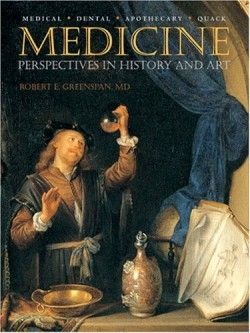Medicine
Perspectives in History and Art
- 2006 INDIES Winner
- Gold, History (Adult Nonfiction)
In the best Hippocratic tradition, the author loves both his art and his fellow men—intensely enough to publish this superbly produced, lavishly illustrated volume on medicine and its presentation in history and art. “Perspectives” is the key word; a single-volume “comprehensive” history defies possibility. Anatomy, surgery, urology, obstetrics and gynecology, and pharmacology are among his themes; dentistry and quackery are also revealingly explored. Greenspan is generously inclusive in his far-ranging, deeply humanistic exploration of his twelve themes. Though necessarily selective, he presents many of great innovators from the ancient and medieval worlds—Hippocrates, Asklepios, Celsus, Galen, Rhazes, Avicenna, Albucasis, Bacon, Paracelsus, Paré among them; the pioneering scientific illustrations of Leonardo da Vinci and Vesalius receive due recognition. Ancient Egyptian, Chinese, and Indian medical theories and principles are briefly treated, but the bibliography opens many doors.
Greenspan’s declared principle is to draw upon people from “both sides of the carefully sharpened scalpels and magically mixed potions” and the long-suffering patient is ever-present as medicine moves uneasily from experience to hope. Great advances were on occasion denied or condemned. In the 1850s the Viennese medical establishment denounced Semmelweiss’s efforts to curb puerperal fever through proper hygiene (Semmelweiss raged about “slaughtered women” and “medical Neros”). In America in the 1860s William Atkinson, first president of the American Dental Association, stated: “… anesthesia is of the devil … man should not be prevented from passing through what God intended him to endure.”
The 500 illustrations are eye-opening, often disturbing: anatomico-surgical topics and procedures abound. Whether depicting a grinning skull, flayed back, gravid uterus, half-severed limb, or merely gleaming scalpels and clamps, the full-color images may cause many readers to sense an emotional frisson in contention with intellectual fascination. No one will read lightly of “being cut for the stone” (lithotomy), or of courageous Fanny Burney’s undergoing a mastectomy in pre-anesthesia days, after reading Greenspan and his historic sources and images. In addition to their informative and educational value, many of the plates reflect the detailed observation and graphic skill that underlie first-class medical illustration—which, prior to the air-conditioned lab, called for immense personal dedication.
The illustrations of Etruscan dental bridges and Renaissance rhinoplasty (the damaged nose thrust into the incised upper arm and immovably taped until regeneration is complete) engagingly introduce age-old self-image concerns. Very different cultural concerns are addressed by illustrations of an unembarrassed sixteenth-century German peasant having a penis wound cauterized in public and by the stand-in ivory doll that allowed eighteenth-century Chinese women to indicate (but not display) areas of medical concern. Likewise, an engaging plate of a French nineteenth-century male midwife “touchant la femme debout” tells much: she is standing up, fully dressed; he is kneeling, wearing a tailcoat; cautious reserve is reflected in each face.
Instruments and instrument kits, often skillfully nested in elegant carrying cases, are well illustrated in addition to being shown in use. The Chamberlens’ famous obstetric forceps are shown in use; these and related devices call to mind the peril and pain of childbirth. Readers seeking a respite need only turn to Greenspan’s appealing section on medical botany. The Chinese herbals, those of Dioscorides, Celsus, and even a nineteenth-century herbalist-physician are discussed; the elegant illustrations will ensure that those in search of deadly nightshade or black hellebore will recognize these most useful plants.
The grim armory of early dental tools is fully redeemed by the magnificent revolver-like Wilcox-Jewett Obtunder cocaine injection device (ca. 1915); surely a must-have for the jet-set jeunesse d’orée. Delightful (if occasionally threatening) devices abound in quackery, many of whose promoters were charming but dangerous rogues. The Pulsocon internal organ vibrator, electric corsets, rectal electrodes, Dynamizer-Reflexophones, and spermatorrhea rings may well fit the great William Osler’s definition as “the foolishness of yesterday”: it is certainly to be hoped they will not reappear “as the wisdom of tomorrow.”
He offers concise but invariably interesting historical sketches of advances in anesthesia, the rejection of amputation fervor, developments in orthopedic surgery and rehabilitative devices; his description of the Civil War, in which lack of hygiene and primitive medical services were the primary killers, strikes a chilling note: much of the narrated horror is drawn from contemporary records.
This volume is a rich and eminently satisfying feast; absentees such as Pepys and his stone and Culpeper and his Herbal are relatively few; doubtless victims of limited space. Readers ready for even larger-scale chronologically-based works can try Garrison’s History of Medicine and Lyons and Petrucelli’s Medicine: An Illustrated History; (see Greenspan’s bibliography). In producing this fine book, the author’s Ponteverde Press has achieved excellent production and visual quality standards.
Reviewed by
Peter Skinner
Disclosure: This article is not an endorsement, but a review. The publisher of this book provided free copies of the book to have their book reviewed by a professional reviewer. No fee was paid by the publisher for this review. Foreword Reviews only recommends books that we love. Foreword Magazine, Inc. is disclosing this in accordance with the Federal Trade Commission’s 16 CFR, Part 255.


